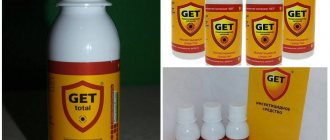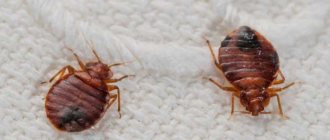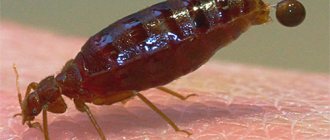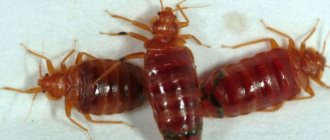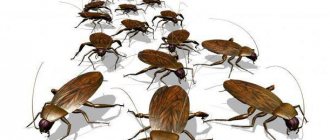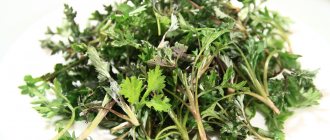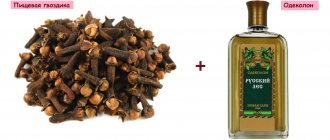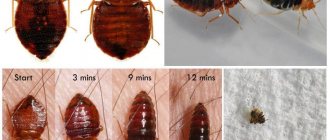Thermal treatment of the contaminated area
Bedbugs are equally afraid of high and low temperatures. Therefore, in order to drive insects away from nesting sites, it is enough to create unfavorable conditions for their existence.
Freezing
If it is established that the bedbugs have not yet spread throughout the room and are only in a specific piece of furniture, most likely it will be a sofa, then it is enough to take it outside in winter.
Bed linen, bedspreads and home clothes should be placed in the freezer and left there for several hours.
Furniture must be left in the cold for two days. Only in this case can you count on getting rid of insects.
High temperatures
Another folk remedy for fighting bedbugs is treatment with boiling water. It must be poured into cracks and corners where insect nests may be located, and the sofa and other pieces of furniture in the room must be treated. After treatment with boiled water, mobile items should be taken out into the open air and left there until completely dry.
A steam generator will have a more gentle effect. The release of steam occurs at high temperatures, which is no less effective than regular boiling water. This device can also be used to treat wall and floor carpets. After pickling, all treated items should be thoroughly dried.
It must be remembered that methods involving the use of high temperatures can damage your furniture. Therefore, you should select weather conditions under which all processed materials are guaranteed to dry.
How to use home remedies
Exterminating bedbugs mechanically is very time consuming, unpleasant and ineffective. This method involves the use of hands, a vacuum cleaner or a regular sneaker. This is a real folk method, which is more suitable not for direct destruction of insects, but for collecting already dead individuals.
Dry grass is laid out in the corners of the apartment and left for several days. The smell repels insects, however, when they become very hungry, they can overcome their disgust and crawl into the house.
The smell of perfume is also unpleasant for bedbugs. Moreover, it does not matter what quality the perfume is. The sharper and richer the aroma, the better it will repel bedbugs. Knowing this, courtiers of the 17th-19th centuries intensively sprayed themselves with perfume. This helped to protect myself from bites at least for a short time.
Those who cannot stand the pungent smell of ammonia can be advised to use vinegar. Wipe the ventilation grilles, door frames, window sills with 3% vinegar, wash the floor with water and vinegar so that bedbugs avoid your apartment.
There are positive reviews about the use of copper sulfate. You can buy it at a gardening supply store. Vitriol is diluted with water in the proportion specified in the instructions and sprayed on the walls, all parts of the bed and the floor are treated.
We suggest you read: Worms in dates: what are they and how dangerous are they?
It is worth paying attention to the fact that strong odors do not kill insects, but only repel them. Either insecticides or heating the room to a temperature above 48° will help to completely remove bedbugs. Home remedies help when it is necessary to prevent bedbugs from crawling from neighboring apartments or to create impossible conditions for the reproduction of insects.
Plants
Bedbugs have a very powerful sense of smell. They need this primarily in order to quickly detect the source of saturation. It is the smell of the human body that is the main guide for the movement of parasites around the room. But they are also able to pick up other scents that will act as a deterrent on them. So, what grass are bedbugs afraid of:
- sagebrush;
- chamomile;
- wild rosemary;
- tansy;
- valerian;
- celandine.
Using wild rosemary
Ledum is an evergreen plant that can be found in the swamp. It contains essential oil, which helps against bedbugs. It has a stupefying and soporific effect. Young shoots of wild rosemary can be used as an insecticide. It is enough to dry the grass and fumigate the room with it.
Ledum is a poisonous plant, so it is necessary to collect it with gloves, and to process the room only with a mask that will protect the respiratory tract.
An infusion and decoction based on this plant will help against an allergic reaction caused by bedbug bites, which allows it to be used as an anti-inflammatory agent.
Dalmatian chamomile
Despite the fact that there are quite a few types of chamomile, only one helps against bedbugs - Dalmatian. It contains pyrethrins, which act only on insects.
Chamomile is used as follows:
- fresh inflorescences must be ground to a powder;
- scatter the product around the room and pieces of furniture;
- leave for 5 days.
Having smelled its aroma, bedbugs will immediately begin to leave their nesting places. Many people do not have time to do this, since pyrethrins can have a paralytic effect. This is where mechanical methods can be used to collect immobilized individuals.
Sagebrush
The special herbaceous smell of wormwood is guaranteed to rid your home of blood-sucking insects. It is enough to put a small bunch of this plant fresh, and the bugs will immediately react and try to leave the room.
These parasites have a very delicate sense of smell, and the pungent smell of bitter wormwood greatly irritates their receptors. But, unfortunately, this happens until the insects get very hungry. In this case, even the proximity of a stack of wormwood will not frighten them and, no matter what, they will again begin to bite a person.
Wormwood helps get rid of bedbugs, not only repelling them, but also masking the odor of the human body. But here it is necessary to clearly determine their habitat, since if you put a bunch under the bed, and the bedbugs live in the mattress, then you cannot expect a positive result. And when insects come from the cracks, fresh grass under the mattress will completely protect the sleeper from bites and will force parasites to avoid the bed.
It is important to remember that wormwood quickly loses its properties after drying, so a fresh bunch will last no more than three days.
To increase the period of influence of this plant on insects, you should make an infusion or decoction based on it, which can be used at any time of the year.
Tincture is a rather expensive product, since to prepare it you need to purchase a liter of pure alcohol. The output volume is also 1 liter. This amount is enough to treat only one sofa, and the mixture will last no more than a week. In addition, the tincture should stand for about a month, and during this time there will be a lot of bedbugs, and this remedy will definitely not help here.
The decoction is more productive. It can be used to treat rooms and furniture several times. It is convenient for them to spray the area, which will significantly reduce the amount of product used. This method is suitable for treating baseboards, corners, crevices and other hard-to-reach places.
Valerian
Another effective herb for bedbugs is valerian. This is a fragrant plant with a high content of essential oils (about 4%). They are the ones who force bedbugs to get out from secluded places, where you will already be waiting for them with a vacuum cleaner or slipper.
To treat the room, you can use bunches of fresh, just picked herbs or a ready-made pharmacy tincture.
Celandine
Poisonous celandine is widely used to repel bedbugs. Its pungent, characteristic aroma is very effective, and it produces the greatest results in the form of a tincture. To prepare it you need:
- chop 180 g of fresh celandine leaves with a knife;
- pour 10 liters of water over the grass and leave for two days;
- After the specified time has passed, add 50 g of laundry soap shavings to the solution and dissolve it completely.
Use the resulting infusion to treat bedbug nests and the area where they move.
Tansy
Tansy will also help rid you of bedbugs. Its smell has a strong effect on insects, which repels them. But it is quite difficult to destroy bloodsuckers with the help of this plant. If bedbugs have been living for quite a long time, and their nests are very large, then it is necessary to prepare a concentrated decoction that is poured into their habitats.
The treated surfaces will repel insects and keep the area from their penetration for 4 days. Then the smell will disappear, and the feeling of hunger will lead the parasites back to the person.
Tansy is poisonous, so it is necessary to remove it out of the reach of children and pets.
For prevention, you can spread dry and fresh tansy branches throughout the room and leave them for several days. This method can drive away a small number of insects if they have already settled in the room. But after some time, if more serious measures are not taken, the parasites will return and reproduce successfully.
Mustard seeds for bedbugs
The use of mustard to combat parasites has been known for a long time; it is still used in Russian villages. It is a safe alternative to chemical drugs. Mustard seeds are steeped in hot water for 30 minutes. The liquid is poured into a container with a spray bottle and the infected areas are treated. Using dry mustard is no less effective. The powder is scattered over baseboards, carpets, and upholstered furniture. Insects cannot tolerate the pungent smell of the spice.
Lavender oil for bedbugs
The strong smell of essential oil disorients parasites in the apartment. When searching for food, they rely entirely on their antennae. They are the organ of smell. Insects capture carbon dioxide emissions. The persistent smell of lavender prevents bedbugs from finding a person. Concentrated oil can be applied to the legs and frame of the bed, but more often it is used in the form of a solution - 20 drops per 250 ml of water. The composition is poured into a spray bottle and sprayed throughout the room. The main attention is paid to the treatment of the bed or other sleeping place.
Attention. Essential oil can cause allergies; before using it, you should test the body's reaction.
Experts recommend preparing a mixture of several types of essential oil. The active ingredients complement each other and have a stronger effect on parasites. Lavender is mixed with peppermint, cloves, and tea tree.
Directions for use:
- Add a few drops of oil to hand cream and apply to exposed areas of the body.
- Soak the napkins in the mixture of scents and place them in the bedroom.
- After general cleaning, wipe all surfaces with a solution of water and a mixture of essential oils.
- Add lavender to an aroma lamp or make a candle based on it.
- Apply a few drops of oil to a wooden bracelet; at night it will protect against insect attacks.
Lavender after bedbug bites
An insect bite causes redness and itching; a homemade remedy will help get rid of the unpleasant consequences. As a base, take baby cream and add 3 drops of tea and 2 drops of lavender oil. The composition is applied to the damaged area.
Folk remedies
Parasites are afraid of temperature changes, strong odors, as well as mechanical actions (for example, an insect can be easily killed using a running vacuum cleaner or the classic way - by flattening it with household slippers).
Throughout the history of the fight against bedbugs, humanity has discovered many ways to get rid of them.
Regular table vinegar helps in killing insects. The advantage of its use is that it is safe for humans and pets, and also has a low price. However, in most cases it only has a repellent effect without killing the bedbugs.
The secret to using vinegar is simple: the stronger the solution, the more effective the product. When processing, apply the product to all areas of the apartment, as well as furniture and surrounding objects. Pay special attention to hard-to-reach places: cracks under window sills, ventilation grilles, baseboards. Remember that bedbugs don't just live in pillows and mattresses.
The most famous recipes using acetic acid solution can be identified:
- Vinegar decoction of wormwood. A good product whose pungent odor helps repel insects. They are good for lubricating places where bedbugs enter the house.
- Naphthalene vinegar alcohol solution 90%. The components are mixed in equal parts, and the insects themselves are irrigated with the solution.
Boric acid
If there are kids in the house, then using boric acid is your choice in the fight against bedbugs. It is non-toxic and completely safe for children and animals. When acid comes into contact with an insect’s body, it corrodes and dries it out, and also affects the bugs’ digestive system.
The product is often used as a bait for parasites. But the fact is that these insects do not react in any way to traps in liquid form, so you should buy acid in powder form. It is poured into the places where bedbugs are located.
If boric acid powder gets on the body of a bug, it first causes scabies and then drying out.
Herbs, flowers and plants have a pungent odor that is unpleasant to insects. They are more effective when harvested in August and September.
Fresh bunches of wormwood or tansy flowers are placed in places where parasites are likely to appear to repel them. An infusion of these herbs is applied to children’s bodies before bedtime to prevent bedbug bites. This product can cause paralysis in insects.
We suggest you read: How to drink wormwood
Valerian infusion has an interesting effect on parasites. Its action is not to repel insects, but to attract them: when they crawl out of their hiding places to the bait, you can begin to use other control methods that can cope with a large number of bedbugs.
Ledum is popularly called bedbug. It has a pronounced aroma and is classified as a poisonous plant. To destroy parasites that feed on human blood, wild rosemary must be collected from August to October. It is during these months that the plant contains a significant amount of essential oils. They use it in crushed form, and also set it on fire (in this case, the bugs are affected by fumigation).
To combat parasites, it is best to collect celandine from May to July in weather without rain. The premises are treated with an infusion of this plant. For the highest concentration of the solution, celandine is infused in water for two weeks, taking as a basis the ratio of 1.5 cups of powder per 10 liters of water.
Chamomile, which is harmless to humans, is poisonous to bedbugs. It contains pyrethrin, which kills parasites. Freshly picked flowers are used: they are crushed and scattered in places where insects are located and appear.
Bedbugs also cannot tolerate the smell of calamus and bay leaves, mint and lavender.
Chemical based mixtures
Folk remedies for getting rid of bedbugs may also include chemicals with a pungent odor. Among the most popular are the following:
- table vinegar;
- denatured alcohol;
- ammonia;
- kerosene;
- turpentine.
- bleach
- copper sulfate
- boric acid
- laundry soap
It must be taken into account that these folk remedies are quite toxic and can pose a danger to the health of humans and domestic animals. Therefore, their independent use is highly undesirable.
Vinegar for bedbugs
The specific smell of vinegar essence can drive various pests out of the house; does vinegar help against bedbugs? When the product comes into contact with insects, it corrodes their integument and also disorients them with a strong aroma. A solution against bedbugs is prepared from vinegar and water 1:1. It is recommended to use a spray bottle to treat the room.
Spray the floors near the beds, furniture, back walls of closets, picture frames, bed frames. As a preventative measure, the composition is applied to ventilation grilles, windows, and doorways. These are the places through which pests enter the premises. Before treating surfaces with vinegar against bedbugs in an apartment, you must wear protective equipment - gloves, goggles, and a gauze bandage.
Table vinegar is not able to eliminate bed bugs; it has a repellent effect. To achieve greater results, it must be used in combination with other chemicals. Don’t forget to renew the treatment, the smell quickly disappears and stops affecting the parasites.
Denatured alcohol
Denatured alcohol in its pure form can destroy bedbugs at any level of their development, but this requires direct contact of the insect with this substance. Therefore, as soon as the nest is filled with denatured alcohol, one can expect the imminent death of the entire colony.
Denatured alcohol is flammable, so surfaces should be treated in full compliance with fire safety measures.
Ammonia for bedbugs
Ammonia or ammonia is a colorless liquid with a characteristic pungent odor. It is capable of irritating the nerve receptors of not only humans, but also insects. The sensitive receptors of bed bugs are inhibited by the smell of ammonia. The product does not kill parasites, but forces them to leave the apartment. It will not be possible to completely eliminate the colony; eggs will remain in the nest, which will give life to the larvae. The advantages of the method are:
- Availability of the drug, it can be bought at a pharmacy at a price of 25-30 rubles.
- The composition is not dangerous to humans if not taken orally.
- The pungent odor of ammonia goes away quickly when ventilated.
Application
Ammonia can be poured into small containers and placed near places where bedbugs nest and move. The second way to use it is by adding it to water during wet cleaning. You will need 3 tbsp. l. for 1 water. Knowing what other smell bed bugs cannot tolerate, you can alternate the compositions. Kerosene and denatured alcohol are used against arthropods. Before disinfestation, residents and pets must leave the premises.
Attention. Containers with ammonia should not be freely accessible to children and pets.
Treating an apartment with an ammonia solution is an excellent preventive measure.
Turpentine for bedbugs
Turpentine is made from the resin of coniferous trees. The composition is rich in essential oils and toxic. It has a repellent effect on household pests. To enhance the effect, turpentine is mixed with other substances. Recipe:
- turpentine – 100 ml;
- naphthalene – 25 ml;
- kerosene – 100 ml.
The prepared solution is applied to the infected areas. To ensure that toxic fumes have an effect on pests, the room is closed for a day. It is advisable to repeat the treatment after 7-10 days.
Strong odors
Bedbugs have a well-developed sense of smell. They can smell human sweat and blood from afar, but other strong odors are unpleasant to them. This feature is often used in the fight against insects. Smells repel bedbugs:
- bitter wormwood;
- medicinal chamomile;
- tansy;
- perfumes and other aromatic products;
- gasoline;
- kerosene;
- vinegar;
- bleach;
- ammonia.
All these are home remedies available to every housewife. They are easy and convenient to use, and the cost is low. Which liquid to choose depends only on the personal preferences of the people living in the apartment. After all, they will also inhale all these smells, and it is not always pleasant to endure them.
What to remember
- Mustard for bedbugs is one of the most effective methods, which, at the same time, will not harm the person himself.
- Unlike various chemicals, mustard is a natural remedy that does not cause allergic reactions or respiratory problems in apartment residents.
- To get rid of house bugs, treat areas where insects accumulate with this powder.
- Re-glue the wallpaper in your house by adding mustard powder to the wallpaper glue - this is both prevention and a method of getting rid of bed bugs.
These are all the main points that we wanted to share with you today. See you in the next article!
Uses of wormwood
Do not forget that copper sulfate is a toxic substance. In order to be poisoned by it, prolonged contact is required, much longer than the time it takes to treat the room. Despite this, if the substance is used incorrectly and safety rules are not followed, a person can cause serious damage to his own health. Rules for working with copper sulfate:
- The use of rubber gloves is mandatory! In case of contact with skin, rinse with water.
- You should protect your eyes. Contact with the solution can cause tearing and redness, so you should use protective glasses during processing.
- The nose and mouth must be protected with a respirator.
Contact with the solution can inflame the mucous membrane and cause allergic reactions. When working with copper sulfate, it is advisable to use rubber gloves, a mask or respirator, and goggles - During processing, the room should be ventilated as much as possible. If there is an exhaust hood in the room being treated, you must turn it on too.
- Children and pets should not be in the room being treated.
After completion of work, clothes should be washed at maximum temperature and dried in the open air. Although the likelihood of poisoning with copper sulfate while treating walls against fungus is almost zero, it is still better to know the symptoms of poisoning:
- nausea, which may be accompanied by vomiting;
- stomach ache;
- weakness;
- in case of contact with skin, may cause redness, rashes and itching.
Copper sulfate is a very effective remedy for mold on walls. If you properly treat and clean the surface, fungal growths will never appear in areas treated with copper sulfate. However, in order to prevent such problems from arising again, it is necessary to take preventive measures: constantly ventilate, ventilate and clean the room.
Source
Similar
It is worth talking in more detail about the use of wormwood, since this herb has long been known for its beneficial properties. Wormwood leaves contain essential oils that emit a characteristic bitter odor. It is unpleasant for bedbugs, and they try to avoid places where wormwood accumulates.
You can prepare a decoction of wormwood, which retains the smell much longer than the dried plant. For one liter of water you need to take 4-5 tablespoons of crushed wormwood. You can pour boiling water over several freshly cut branches and then leave for half an hour. As a result, a concentrated liquid is formed, which is used to lubricate bed parts, ventilation grilles and other places through which insects can enter the house.
